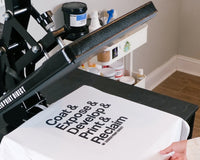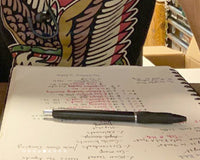Screen printing is the most basic form of transferring an image to a garment. It’s been around for well… a long time! Approximately 221 AD (we’ll feed your curiosity). Besides the creative side of screen printing, another reason screen printing is a popular business is because it’s relatively cheap to start.
As screen printing has evolved many printing techniques and styles have emerged. There isn’t a right or wrong way to print. Printers choose their printing approach based on the job at hand. As business owners, screen printers are always striving for a more profitable bottom line. Today we compare two methods, plastisol transfers vs screen printing (traditional form)
First, we will briefly break down the screen-printing process. This is necessary to understand plastisol heat transfers.
Traditional screen printing can be a lengthy process. It starts with a stencil being burned into a screen using emulsion, light and a film positive. Once the stencil is created, ink is passed through the screen using a squeegee. The ink is then cured onto the garment using heat. This is a very short brief of the process, if you would like a breakdown of this process please read this blog post.

Now that you understand traditional screen printing, we will discuss, what is a plastisol transfer?
Plastisol Transfers are screen-printed designs that are printed on a unique heat transfer paper rather than screen printing directly to a garment. Once the design is screen printed onto the sheet, the printed heat transfer sheets are ready to be transferred onto any garment (t-shirts, sweatshirts, hats, etc.) with a heat press.

Plastisol transfer vs screen printing
Note that plastisol transfers are still screen printed. The big difference is that instead of printing directly onto a garment the transfer is printed onto transfer paper to be printed later. Another critical difference is that plastisol transfer must be made “mirrored” or flipped. The image will be backwards if you transfer it without flipping the image first, this is not true with traditional screen printing. Plastisol transfers should also be used with transfer powder, while it’s not necessary it is highly recommended for a smooth transfer and a long-lasting quality print for your customer.
Traditional screen printing and plastisol transfers have a very similar process however the big difference between these two is the scenario in which both are used.
Plastisol transfer prints are great to use for the following scenarios:
- Printing on tough substrates
- For small print runs
- Live printing – No prior knowledge to client sizing
- Customization – such as sports jerseys
When printing on a tough substrate such as fleece, heat pressing on a design instead of a push/pull with a squeegee might be more ideal and give you a crisper final print.
If you are printing a very small print run it might be easy to print a bunch of transfers and heat press the t-shirts instead of aligning and setting up a lot of t-shirts on your press.
Live printing is a great time to use plastisol transfers. Let’s say you are printing for an audience, and you have no knowledge of what sizes you will need for the live printing session. With transfers you can print your art at home. Then you can take the transfers and print it onto the size requested by the customer. This way you don’t pre-print a bunch of t shirts and waste the garments. Also, a heat press is much more portable than a conveyor dryer to cure the ink.
Traditional Screen Printing Benefits when compared against Plastisol Transfers
- Halftones - Images with more detail. You can't produce this type of print with a plastisol transfer
- Ideal for large orders - Traditional Screen Printing is great for pumping out large volume orders. Plastisol transfers are not ideal because it involves an extra step and extra product
- Higher Profit Margins - Tradtional Screen Printing generates more profit. Additional time and supplies printing plastisol transfers eats into profit
Business Opportunity Alert:
You can sell your plastisol transfers! Not everyone has a full screen-printing set-up, you can screen print transfers and sell your designs to shops that just want to heat press them on. This is a very popular in the tourist niche and for trendy boutiques that are producing fast fashion pop culture graphic tees.
If you are printing with plastisol transfers, we would love to hear any advice or tips you can share with printers. If you don’t like to use them, we want to hear about that too!
Questions? – Let’s Talk. Remember, we are here to help! Drop a comment below or email our support team at info@screenprintdirect.com







